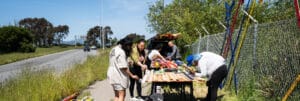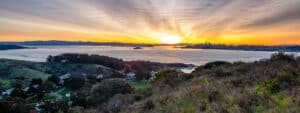By Paul Rogers, San Jose Mercury News
A presidential race, a U.S. Senate race and an avalanche of ballot measures that would do everything from legalize marijuana to end California’s death penalty are drawing most of the attention as Election Day nears.
But across California, a record $4.1 billion in ballot measures to preserve parks and open space are also vying for voters’ attention in what could become a wave of green riding the tide of a rebounding economy and record voter turnout.
Environmental groups and developers are closely watching the measures, which could shape the landscape in the Bay Area and Southern California for decades to come by raising new money for trails, parks and open space preserves. Others would impose strict development limits outside existing city boundaries.
“It’s not the sort of thing that’s as dramatic as a presidential election, but it matters,” said Tim Ahern, a spokesman for the Trust for Public Land, an environmental group in San Francisco. “The economy is better. People are feeling like they want to invest.
“And they want a nice park to take their kids to — or to go jogging in or walk their dog. These measures pass in red states and blue states.”
Among the issues that will appear on the ballot Nov. 8 are tax hikes in Los Angeles and San Diego counties that would fund parks and trails, while voters in communities from Monterey to Sonoma counties are weighing in on similar measures.
In Monterey County, Measure E, is a $25 annual parcel tax that replaces an expiring assessment, and is expected to raise $24 million for the Monterey Peninsula Regional Park District over the next 20 years.
In Hayward, Castro Valley, San Lorenzo and nearby communities, a $250 million bond would fund parks, playgrounds and trails. And Measure H in Gilroy would put an urban growth boundary around the city, limiting new development on farmland.
Most of the tax measures require a two-thirds majority vote to pass. In many cases, developers and other groups with concerns about the proposals have not mounted formal campaigns, but are urging voters to vote no.
“We all love open space, but where are our kids and grandkids going to live and work? Where are they going to have to move to own a house?” said Lisa Vorderbrueggen, a spokeswoman for the Building Industry Association of the Bay Area, based in Walnut Creek.
Brian Schmidt, program director with the Greenbelt Alliance in San Francisco, countered that there’s plenty of land to build new housing on — and it should be done within existing city limits, particularly near rail and other transit systems to reduce traffic.
“The type of sprawl developments you see in these areas outside city limits are some of the least dense and least affordable housing,” he said. “It does not do much to solve the housing problem in the Bay Area.”
“People want to preserve the scenic beauty,” he added. “They don’t want cities to endlessly sprawl into one another.”
In recent years, major open space measures have generally passed. A $23 per parcel tax in 2014 for open space, parks and beaches in Los Angeles County narrowly fell short of the two-thirds majority needed. But in June, 70 percent of voters in the nine Bay Area counties approved a $12 parcel tax for restoration of San Francisco Bay and its wetlands, guaranteeing $500 million over the next 20 years.
A huge turnout in deep blue California, combined with the revitalization of the economy means the measures have a tailwind, said Daniel Press, a professor of environmental studies at UC Santa Cruz.
“If you take the advocates of these measures out for a drink, many of them will say they wait for an economy that is doing relatively well and a general election,” Press said. “They want to ride on the coattails of other issues. Right now is probably the best time you can put measures like this on the ballot.”
This article was originally published in the Monterey Herald.




